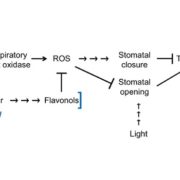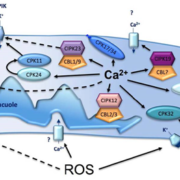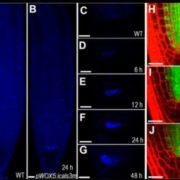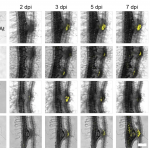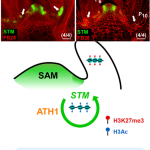Self-isolation to the rescue – how plasmodesmata initiate signaling in response to chitin (PNAS)
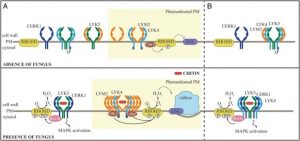 Plant cells are known to initiate local and systemic signaling in response to certain stressful conditions to safeguard cells in the immediate vicinity as well as that are far from the site of stimuli. In this study, Cheval and co-workers have characterized a pathway in plant cells for sensing and responding to chitin, a polysaccharide and chief constituent of fungal cell walls. This pathway occurs in plasmodesmata, the tunnels that connect adjacent cells through symplastic transport systems. In response to chitin, a receptor-kinase pair of LYM2-LYK4 has been shown to get activated, enabling callose deposition to plug plasmodematal connections, resulting in the isolation of individual cells. Curiously, this callose deposition also depends on two calcium-dependent protein kinases (CDPKs) and the NADPH oxidase, RBOHD, though connections between LYM2-LYK4 and these proteins are yet to be deciphered. These results imply the need for Ca2+ and/or ROS signals, if any, to enable plugging of plasmodemata, which needs further experimental validation. The authors summarize, “This work characterizes how a cell can produce a localized and specific response in a discrete membrane domain, identifying that there is microdomain specificity in immune signaling to a single elicitor and that cell-to-cell connections are independently controlled. “ (Summary by Pavithran Narayanan) Proc. Natl. Acad. Sci. USA 10.1073/pnas.1907799117
Plant cells are known to initiate local and systemic signaling in response to certain stressful conditions to safeguard cells in the immediate vicinity as well as that are far from the site of stimuli. In this study, Cheval and co-workers have characterized a pathway in plant cells for sensing and responding to chitin, a polysaccharide and chief constituent of fungal cell walls. This pathway occurs in plasmodesmata, the tunnels that connect adjacent cells through symplastic transport systems. In response to chitin, a receptor-kinase pair of LYM2-LYK4 has been shown to get activated, enabling callose deposition to plug plasmodematal connections, resulting in the isolation of individual cells. Curiously, this callose deposition also depends on two calcium-dependent protein kinases (CDPKs) and the NADPH oxidase, RBOHD, though connections between LYM2-LYK4 and these proteins are yet to be deciphered. These results imply the need for Ca2+ and/or ROS signals, if any, to enable plugging of plasmodemata, which needs further experimental validation. The authors summarize, “This work characterizes how a cell can produce a localized and specific response in a discrete membrane domain, identifying that there is microdomain specificity in immune signaling to a single elicitor and that cell-to-cell connections are independently controlled. “ (Summary by Pavithran Narayanan) Proc. Natl. Acad. Sci. USA 10.1073/pnas.1907799117




